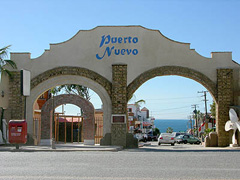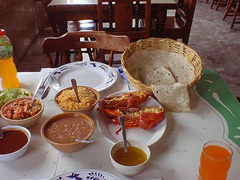Rosarito Beach - Baja, Mexico Rentals
Las Gaviotas Rosarito
Calimar Properties - The Hospitality People!


In 1954, Rosa María Plasencia's father came to live in what's now the famous lobster village of Puerto Nuevo. He came because he'd heard there were lots of lobsters there. A year later, Rosa María's mother's family came. The two young people met, fell in love, married and built a tiny house across the street from what is now the family restaurant, Puerto Nuevo II.
At that time, there were only two or three families living on the cliffs overlooking the Pacific. Every day the men went out to sea in their pangas. Every afternoon their wives would scan the waters until they saw their husbands' boats materialize on the horizon. Once a positive sighting was made, they'd rush to heat up beans and rice, pound out some fresh tortillas and put a kettle of lard on the fire. The men always came back ravenous, and when they unloaded their catch of lobsters, they'd slice a few in half, drop them into the bubbling lard and fry them up. There was no refrigeration, so the now-famous meal of fresh fried lobster, beans, rice and tortillas came into being purely out of necessity.

In about 1956, Rosa María's father sent to Guadalajara for his brother and sister. They came and joined in the fishing and cooking. A few more families migrated to the area. One built a little stand next to the bus stop, where the welcoming arches are now. They sold sodas, snacks and burritos. Next to their stand was a billboard advertising New Port cigarettes. Americans would show up and ask the men to take them fishing in their pangas. When they came back in, they'd join the Mexicans in a big meal. The Americans named the village after that sign, which, translated into Spanish is Puerto Nuevo!
Over the years more and more people came from central Mexico. Some were intent on making their way to the USA, but stayed to fish and serve lobsters to the ever-growing crowds of visitors. A political activist, Señora Rentería, helped the families in Puerto Nuevo to get a grant from the government so they could have additional land to build on. She succeeded in getting 17 plots of land assigned to the locals and in gratitude for this; they named the village's main street after her. Restaurant Puerto Nuevo I founded by Rosa María's aunt and stepfather was built on the first lot assigned. Puerto Nuevo II was built on the second lot, and got its name because of it. A third family built yet another restaurant. All of them charged about 50 cents for a lobster dinner back then. A major growth spurt occurred in Puerto Nuevo in the '70s when the Ortega family came to town and built four restaurants, which they publicized widely.